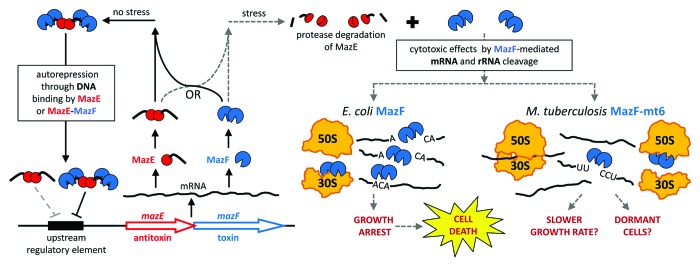
Figure 1. MazF toxins inhibit translation and arrest growth by cleaving mRNA and rRNA. All mazEF operons consist of two adjacent genes, one that encodes the intracellular toxin MazF and another that produces its inhibitor, antitoxin MazE.37 In the absence of stress, the MazE protein forms a stable complex with the MazF toxin to neutralize its toxicity.6,38 The MazEF heterohexamer complex (2 MazF: 2 MazE: 2 MazF)39 and to a lesser extent, the MazE dimer, repress the operon by binding to an upstream regulatory element that consists of a palindromic DNA sequence.10,40 The intrinsically unstable MazE antitoxin can be degraded by cellular proteases,6,7 which frees and activates the MazF toxin. The toxic activity of MazF is triggered by stresses such as nutrient limitation, DNA damage, high temperature, oxidative stress, or exposure to various antibiotics.6-9 MazF orthologs exert their cytotoxic effects by cleaving single-stranded RNA at unique and specific 3-, 5-, or 7-base sequences.1,11-23 Although MazF toxins were initially proposed to solely cleave mRNA as “mRNA interferases,”11-20E. coli MazF also cleaves 16S rRNA in the 30S ribosomal subunit,24 while M. tuberculosis toxin MazF-mt6 also cleaves 23S rRNA in the 50S subunit.1 Cleavage of mRNAs or rRNAs disrupts protein synthesis,1,12,24 which can induce a state of reversible dormancy.41 Expression of MazF triggers this “quasi-dormant” state, during which cells stop dividing but are able to transcribe mRNA and synthesize proteins.42 Due to its recognition of a relatively short RNA sequence (ACA), E. coli MazF cleaves a majority of cellular mRNAs. In addition, not only can MazF render certain mRNAs leaderless by cleaving an ACA sequence upstream of the start codon, but it also removes 43 nt from the 3′ end of 16S rRNA to create “stress ribosomes” that selectively translate either naturally present or MazF-generated leaderless mRNAs.24E. coli MazF has also been shown to initiate cell death if its toxic effects are not neutralized by MazE in sufficient time.6,8,9,43 In contrast, M. tuberculosis toxin MazF-mt6 is expected to cleave only a subpopulation of mRNAs due to its recognition of the five-base RNA sequence UUCCU. However, MazF-mt6-mediated cleavage of 23S rRNA in free 50S ribosomal subunits is sufficient to inhibit protein synthesis,1 so combined cleavage of mRNA and rRNA may elicit rapid growth arrest. The effect of MazF-mt6 on M. tuberculosis cells in vivo has not been rigorously investigated, but two possible endpoints are shown.
